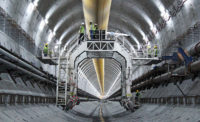
While post-Panamax ships boost the global economy by moving goods through the Panama Canal's third set of locks, a striking new cable-stayed bridge will support local business by transporting materials overland. The 1,050-meter-long third crossing over the canal has a 530-m-long main span that, when completed in 2016, will be the longest in the world for a four-lane concrete cable-stayed structure. It will provide a vital link between the seaport city of Colón and communities such as Bocas del Toro, a popular tourist destination.
Ever since the canal was built, a swing bridge has been the only way to cross the existing canal by road on the Atlantic Ocean side, says Oscar I. Soto Reyes, project supervisor with the Panama Canal Authority (ACP). "But once the third set of locks is completed, the road will not exist anymore."
As a result, in a joint venture with the China Communications Construction Co.-Highway Planning and Design Institute, the Louis Berger Group designed the third fixed crossing and more than 2 kilometers of related concrete segmental approaches and access roads. The system is designed to handle explosive traffic growth to and from Colon up to 2073, says Soto Reyes.
Gabriel Borras, Berger's director of Latin America and the Caribbean, says the main reason for the record concrete central crossing is that the bridge has to span the canal where the access channels merge with the new lane's locks and the existing locks, without affecting navigation. "No part of the foundations could enter the external edge of the navigation prism's slope," he says. Because one of the 212-m-high, delta-shaped pylons sits in the water, "there had to be a buffer zone between the vessel grounding area and the tower foundations," adds Borras. "Adding the minimum distances together meant the main span of the bridge had to have a minimum of 530 m."
Concrete superstructures are rare in 500-plus-m crossings. Soto Reyes says ACP decided not to go with a composite structure because of the salinity issues, as the project is sited so close to the Atlantic. The heavy concrete girders also meant a much larger number of cable stays than typical—256. Vinci Construction Grands Projects, France, will build the bridge under a $366-million contract. The 50-m-long piles, up to 2.5 m in dia, are underway.




Post a comment to this article
Report Abusive Comment